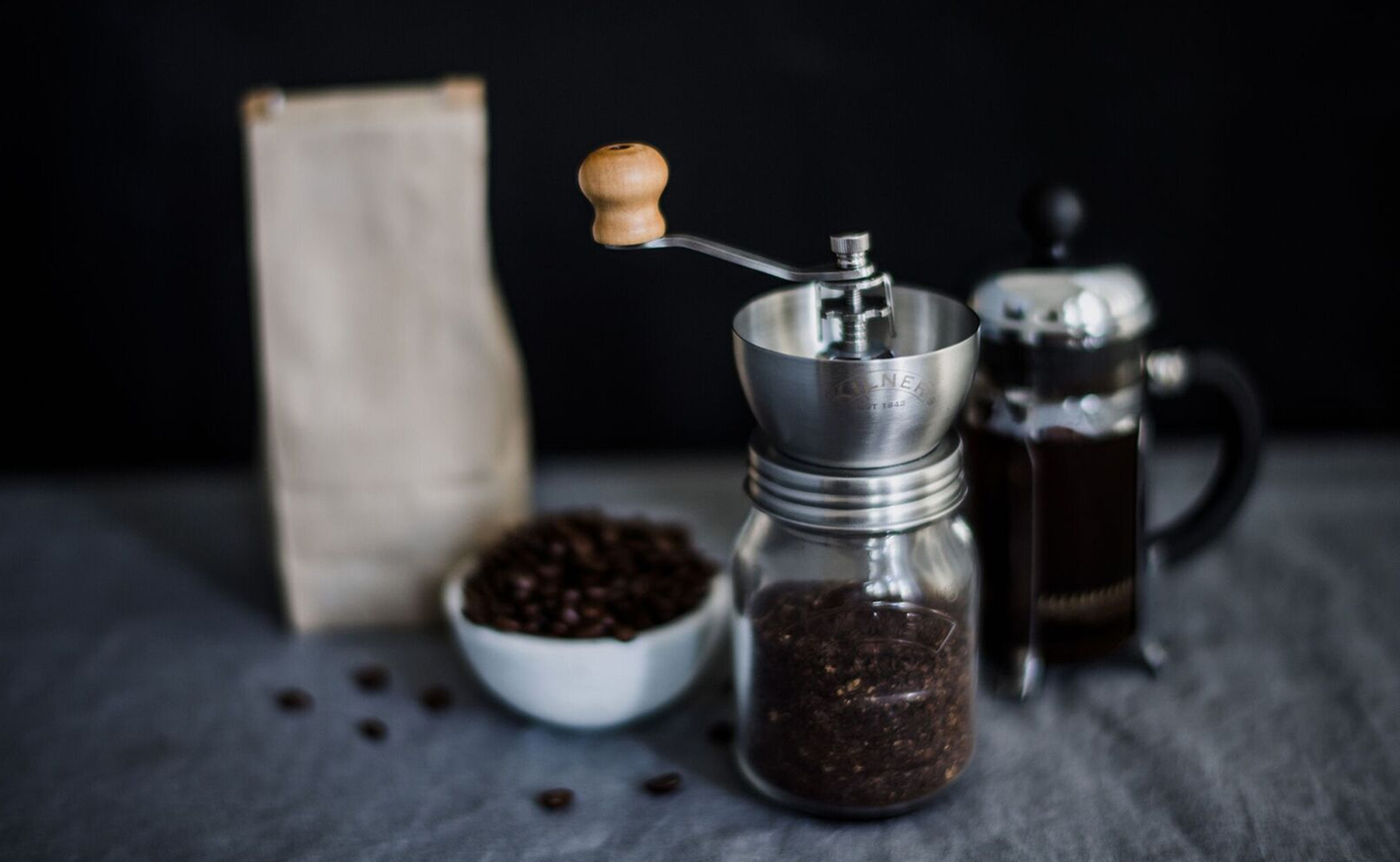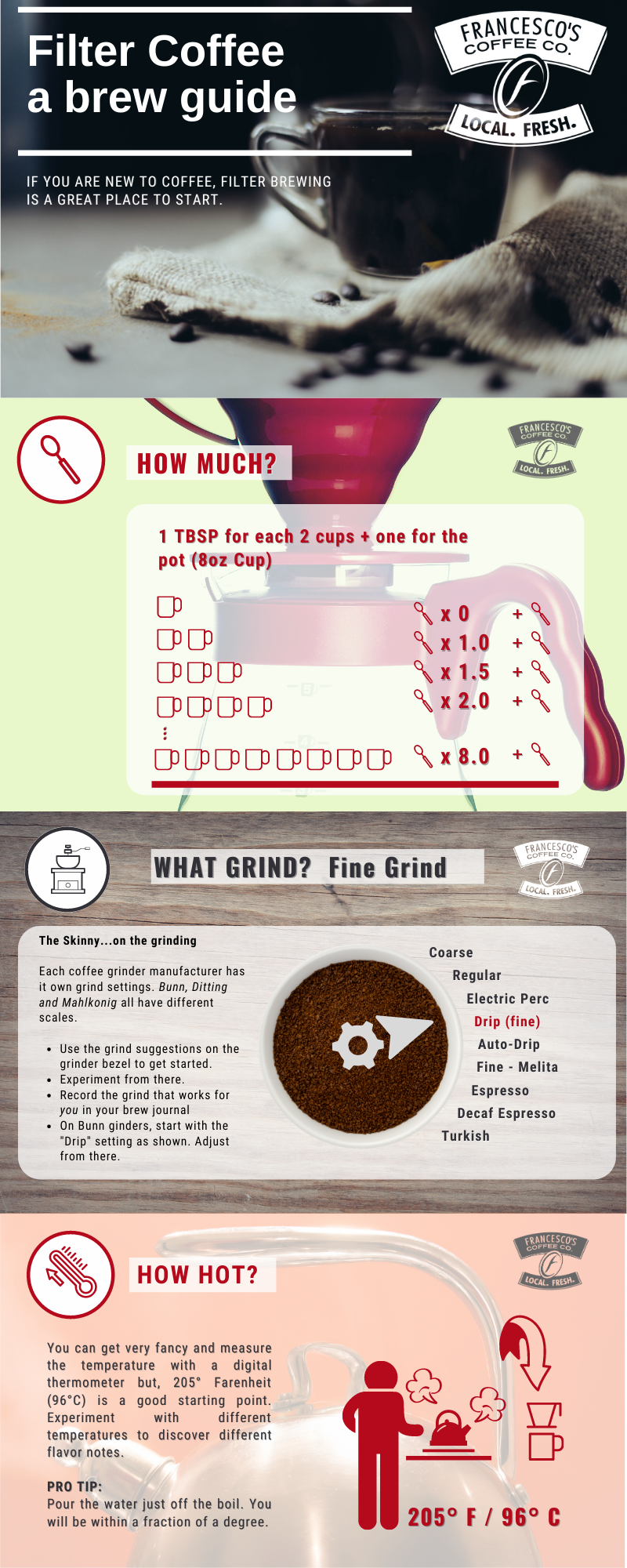Filtered Coffee – A brew Guide
An Introduction
Filter Coffee is easy and a staple in most of our diets. It’s super easy to get a quick cup of joe on those early mornings. There is an infinite selection of filter brewing methods and an equally infinite selection of electric coffee appliances to choose from. The aim of this post is to provide a general understanding of some “best practices”.
What you’ll Need
Coffee
Coffee Filters
Filter Funnel
Grinder (optional)
Kettle
Brew Time
4min
Easy Peasy – The basics
In it’s most basic form , filter coffee is made up of only 5 elements – One of which is Coffee.
- Filter basket
A container that allows the filter to retain its shape. - Filter
Any screen that allows water to pass through and coffee grounds to “stay in”. - Coffee Pot
The container the extracted coffee falls into. - Coffee
The cherry from any family of the coffee plant roasted suitably for extraction - Water
- Source of heat
Could really be any kind of heat source.

Easy-peasy right? But wait…it gets better. You only have to control three of these elements to be in coffee heaven.
- Coffee quantity,
- Coffee Grind,
- Water temperature
What could go wrong? Plenty, as it turns out.

how much Coffee should you use?
It’s hard to give universal advice on how much coffee to use. Everyone’s tastes and preferences are so different. One rule that might be considered as “tried and tested” is:
- Use ONE tablespoon for every TWO cups of coffee
- Next, add one single tablespoon “for the pot”. This gives a more rounded taste.
General Dosing Advice
Ultimately there are no right or wrong answers. Ultimately, what tastes great to you, may taste awful to someone else so the common sense approach is to start with a generally accepted rule and explore from that “setting/quantity ” until you find the flavor that tastes good to you.
Keep a coffee journal
One good practice is to weight out the quantity that you are experimenting with and keep some form of a simple journal. That way when you “nail” the recipe that is perfect for you, you can return to it. Weighing coffee, is more precise and repeatable than measuring out by volume.
How should I grind the Coffee – Turns out grind size matters
What it all comes down to is three simple parameters:
- Contact time
The time the water is in contact with the coffee. The finer the grind the longer the contact time.
If you wish to increase the time the coffee steeps for, make the grind finer. - Extraction rate
The rate at which solids and volatile compounds are extracted from the coffee. The finer the grind the greater the extraction rate.
If you wish to increase the amount of solids and volatile compounds extracted, make the grind finer.
- Flow rate
The rate at which the water passes though the coffee. The finer the grind the lower the Flow Rate.
Slowing the Flow rate increases the contact time. The flow rate is sometimes controller by equipment makers by means of the diameter of the evacuation holes at the bottom of the filter holder. You can affect the flow rate by making grind finer.
Perhaps a useful analogy is that of a gravel pile versus a sand pile of the same mass. Which lets water pass faster?The gravel pile of course! Why because the total surface area of the gravel rocks is so much SMALLER that the total surface are of all the tiny little grains of sand.

General Grind Advice
very fine grinds
Filtered coffee doesn’t do well with very fine grinds. You may find that a very fine grind extracts undesirable notes from your origin or blend.
very course grinds
Course grinds tends to make filtered coffee “syrupy” and weak. The cup will loose it’s body and even the finest artisan coffee beans become meaningless swill.
the solution
Fortunately, there is a happy balance. It’s often labelled as Fine Grind and you can easily identify it on your super market grinder or home grinder. See the handy grind chart above to “eyeball it” and then go from there using your brewing journal to record your experiences.
Water Temperature and quality
Depending on the varietal or blend, the ideal water temperature for a filter coffee extraction will be very near 96-97 °C/205 °F.
Here too, you can get pretty sophisticated with your measurement of temperature but there are three easy rules that will have a huge impact on the extraction quality.
General Water Advice
- Better too hot than too cold. Pour water right off the boil. Don’t dally , don’t hesitate, don’t blink…just pour the water. Do it NOW!
- As you pour water into the filter, use a circular motion to wet all the grounds and to “stir” the bloom that appears. This is very important and has huge impact on the amount of dissolved solids you extraction will contain. The more dissolved solids, the better the flavor and body of the cup.
- Use clean water that does not have strong odours or flavours. If your area does not have good water, consider filtering the water through a filtering carafe of some sort.
Speaking of brewing techniques, you might be interested in coffee preparation. If you’re curious about the importance of water quality in brewing, check out water filtration. And for those who want to delve deeper into the nuances of flavor, the article on coffee tasting is a great read. Lastly, if you’re considering keeping a record of your coffee experiments, understanding the concept of a
2 Comments
A coffee “scoop” is typically 1 tablespoon (tbsp), which is 5 grams of ground coffee.
Some coffee machine manufacturers provide scoops which are 2 tablespoons (tbsp).
There are also double-sided coffee scoops, with 1 tbsp on one end, and 2 tbsp on the other. You’ll have to verify what size scoop you’re using.
Regardless of the type of scoop you have, you’ll want to use 2 tbsp (10g of coffee) per 180 mL (6 fl. oz) of water.
Awesome comment! Thanks Stefan.